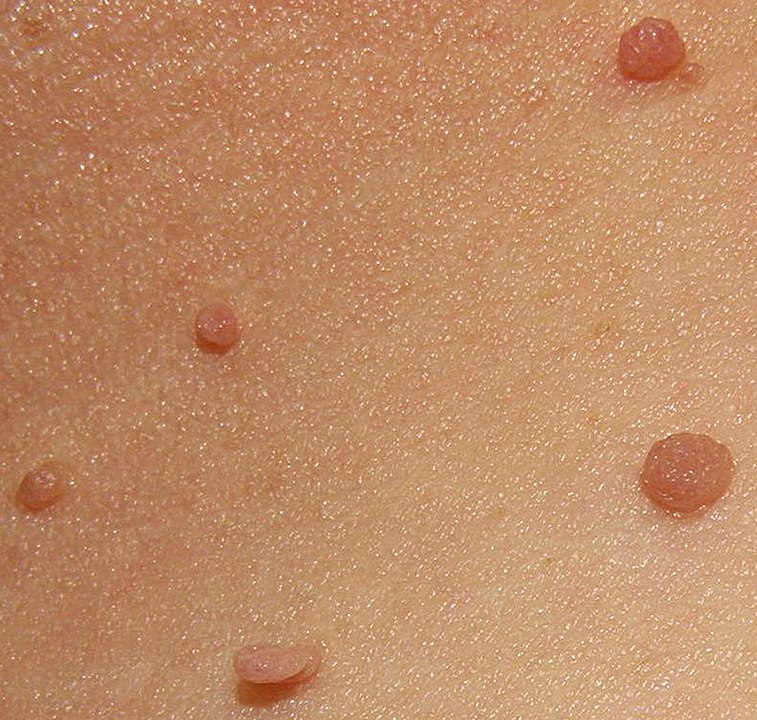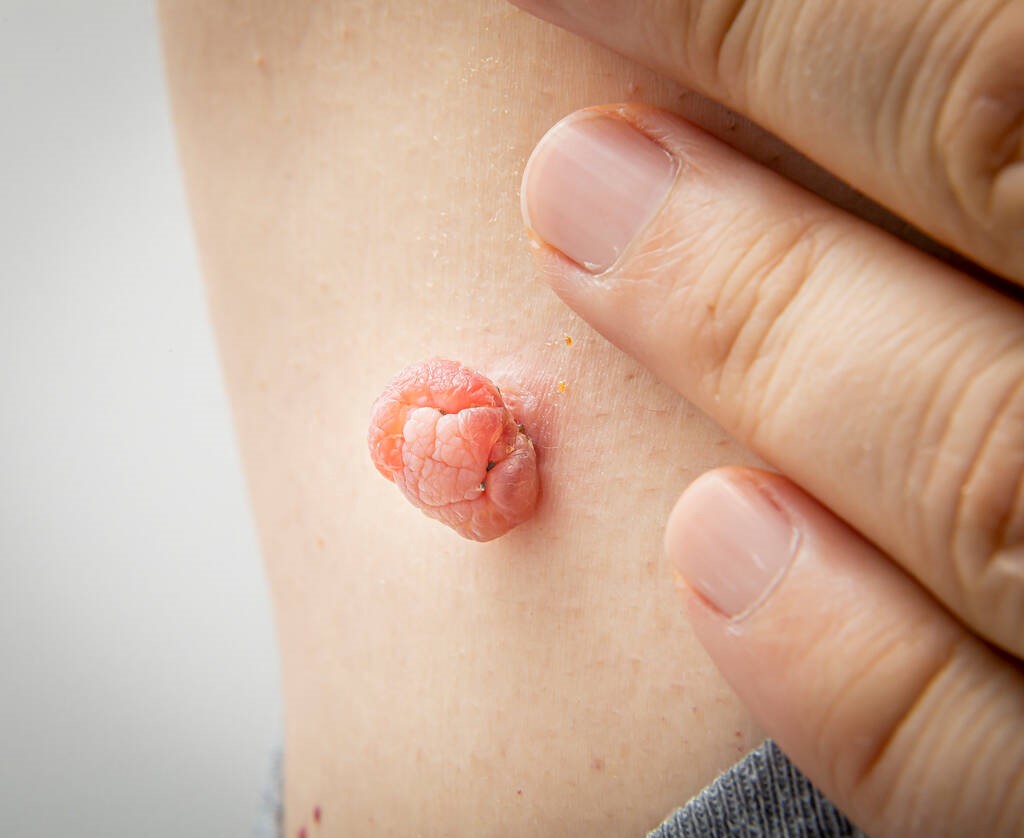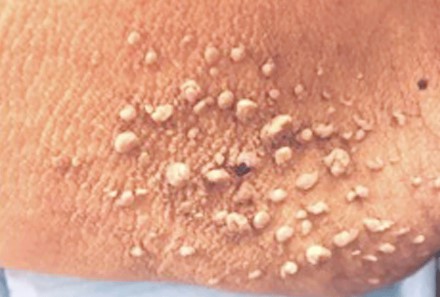Skin Tag Removal
Skin tags are an extremely common skin condition that affects as many as 46% of the general population, and more than 3 million new cases are diagnosed in the United States each year. Characterized by soft, flesh-colored skin growths typically connected with a thin stalk, skin tags are more common among adults over the age of 40. Skin tags—also known as acrochordons—most often form when skin rubs together and are most commonly found in the neck folds, armpits, groin area, breasts, and eyelids. While skin tags are harmless growths, they can appear in highly visible areas of the body, contributing to many patients’ desire to have them removed. In some cases, skin tags can rub against clothing, causing itching, skin irritation, and even bleeding. The best first step for patients looking to remove their skin tags is to schedule a consultation appointment with an expert board-certified dermatologist, such as Dr. Michele Green.
Dr. Green has several skin tag removal treatment options at her Upper East Side New York City dermatology office, including electrodesiccation, cryosurgery, and excision. The best treatment depends on the location, size, and shape of the skin tag, and Dr. Green may combine treatments for the best results. Electrodesscation entails using a tiny needle to deliver an electric current to cauterize the skin tag, which eventually scabs up and heals. Smaller skin tags may be treated with cryotherapy, which involves the direct application of liquid nitrogen to freeze the skin tag upon contact with the skin. Larger skin tags with a thicker stalk may be removed with surgical excision, and a biopsy may be sent for histological review to rule out other skin conditions, such as warts or skin cancer. If you would like to find out which treatment option works best for you, you can go ahead and schedule your first appointment with Dr. Green.
Experienced board-certified dermatologist Dr. Michele Green has been expertly treating patients in her Upper East Side New York City dermatology office for more than 25 years. Highly adept at a wide range of medical and cosmetic treatments, including skin tag removal, Dr. Green is an expert at generating individualized treatment plans to suit each patient’s unique needs and aesthetic goals. Well-known for high patient satisfaction, Dr. Green has been consistently voted one of the best dermatologists in New York City by such publications as Castle Connolly, Super Doctors, and New York Magazine.
What are skin tags?
Skin tags, also known as acrochordons, are benign skin lesions that can grow on areas of the body where the skin is constantly rubbing together, including the armpits, neck folds, groin, breasts, eyelids, and buttocks. Often ranging in size from two millimeters to one centimeter, these skin lesions are composed of collagen and blood vessels and surrounded by soft skin tissue. Sometimes, they hang from the affected area by a thin stalk of skin tissue and are usually flesh-colored or a little darker. Skin tags may form individually, but they often appear in clusters. While these skin growths are harmless, meaning they are not indicative of skin cancer, they can form in highly visible areas, causing patients to want them removed for cosmetic reasons. Some patients may find skin tags itchy and irritating when they rub against clothing.

NeckAcrochordons By Jmarchn – Own work, CC BY-SA 3.0
Why do skin tags appear?
The exact cause of skin tags is not yet known. However, several risk factors can contribute to the appearance of skin tags. Often, skin tags develop when the skin rubs against itself, meaning that patients who are pregnant, overweight, or have loose skin are more likely to experience skin tags. Patients with a family history of skin tag development are also likely at a higher risk of developing these skin lesions. Skin tags have also been associated with other conditions, including:
- Obesity
- High levels of growth factors
- High cholesterol levels
- Hypertension
- High blood pressure
- Insulin resistance
- Some types of HPV
- Fluctuations in levels of estrogen and progesterone
What is skin tag removal?
Skin tags are harmless growths that affect more than 3 million Americans each year. While they are quite common, they can often appear in highly visible areas of the body, including the face (eyelids) and neck, causing patients to want them removed for cosmetic reasons. Skin tags can also form in areas that rub against clothing in itchy or uncomfortable ways, such as under the breasts, in the armpits, and the genital area. Patients looking to have their skin tags removed should start by consulting with a board-certified dermatologist, such as Dr. Green, who can recommend the skin tag removal method that will best suit their needs. Typically, Dr. Green will turn to electrodesiccation, which uses an electric current and cauterization to remove the lesion; cryosurgery, which employs liquid nitrogen to freeze off the growth; or excision, which is when surgical scissors are used for snipping the skin tag.
Should skin tags be removed?
Unlike other growths that can appear on the skin, skin tags are harmless and are not associated with skin cancer. Melanoma lesions, which are associated with skin cancer, differ in appearance from skin tags in several ways. While skin tags tend to protrude from the body, often hanging from a thin stalk, melanoma is usually flat and smooth. Skin tags are often flesh-colored or slightly darker than your skin color, while melanoma usually appears as a much darker spot. Additionally, melanoma is characterized by ragged, irregular borders and an asymmetrical shape. While skin tags look different from melanoma, it is always best to have new skin growths examined by a healthcare professional or expert dermatologist, such as Dr. Green.
As skin tags are not dangerous, they do not typically need to be removed for medical reasons. However, many patients may find cosmetic reasons for wanting them removed, especially when they appear on the face or neck. Some patients find that the skin growths rub against clothing, causing them to become itchy, irritated, and even bloody. Additionally, skin tags can grow on the eyelids, which can inhibit a patient’s vision. In that case, Dr. Green often recommends removing the skin tags to increase patient comfort on a day-to-day basis.
Who removes skin tags?
Patients who are looking to have their skin tags removed should schedule an appointment with an experienced board-certified dermatologist, such as Dr. Green. When you arrive for your appointment, Dr. Green will begin by examining the growth to diagnose the lesion. Different types of skin growths, such as skin tags, seborrheic keratosis, warts, moles, and pre-cancerous lesions, may require different treatment options. If a patient is experiencing skin tags, Dr. Green will assess the size, shape, color, and location to determine which skin tag removal method will work best. If your skin tag removal process requires a local anesthetic, be sure to disclose any relevant health information, such as allergies, before the procedure begins. While there are home remedies for skin tags available on the market, they are less safe and effective than undergoing skin tag removal treatment at the office of a qualified dermatologist.
Best skin tag removal method
Several skin tag removal treatment options are available at Dr. Michele Green’s Upper East Side New York City dermatology office:
Electrodesiccation
Electrodesiccation, or electrocautery, is a safe and effective method for skin tag removal. It uses a tiny needle to deliver an electric current, which heats and cauterizes the skin tags, causing the growth to scab over and eventually fall off. To keep the wound clean, patients should apply Bacitracin ointment or Aquaphor to the treated area for several days after the skin tags are removed.
Cryotherapy
Cryotherapy, or cryosurgery, is a skin tag removal procedure that involves the use of liquid nitrogen to freeze the growth. At -320 degrees Fahrenheit, liquid nitrogen can cause severe burns if not administered properly, meaning patients should always seek out an expert dermatologist for the procedure. Even when performed correctly, the skin tag may blister and scab within a few days after the liquid nitrogen is applied, and proper wound care is necessary to prevent scarring. Due to the possibility of scarring, liquid nitrogen is not the preferred method of treatment for skin tag removal.
Excision
For larger skin tags with a thicker stalk, surgical excision is usually recommended in addition to electrodesiccation. The skin is prepped prior to the procedure with topical anesthesia or an injection of a local anesthetic to numb the treated area. Once the area is numb, the provider snips the skin tag with sterile surgical scissors or excises it with a scalpel. After the growth has been excised, the area may additionally be cauterized using a hyfrecator. Since skin tags have their blood supply, cauterization will stop any further bleeding by sealing the blood vessels.
What is the most effective skin tag removal product?
The best treatment option for skin tag removal depends on several factors, including the size of the growth and its location on the body. For smaller growths, Dr. Green will most often turn to electrodesiccation, which uses an electric current to heat and cauterize the skin lesion. For larger growths attached to the skin with a stalk, Dr. Green will typically combine electrodesiccation with excision, surgically removing the growth with surgical scissors or a scalpel. Due to the associated discomfort and risk of scarring following treatment, Dr. Green avoids cryotherapy. To find out which treatment method works best for you, you can schedule your first appointment with board-certified dermatologist Dr. Michele Green.
How long does skin tag removal take?
Skin tag removal is a quick outpatient procedure, even when surgical excision is performed. Still, the exact time it takes depends on the size and location of the skin growth. Electrodesiccation typically takes 10 minutes to perform, while excision often takes less than 30 minutes. Patients can mostly return to their regularly scheduled activities, though the wound created when the lesion is removed takes five to seven days to heal fully. Patients should carefully follow all aftercare instructions to keep the wound clean.
Is skin tag removal painful?
When seeking treatment from an expert dermatologist, such as Dr. Green, patients should not experience any significant discomfort during the procedure. Before performing skin tag removal with a more invasive treatment method, like excision, Dr. Green will apply or inject a local anesthetic to numb the treatment area before the surgery. To reduce any discomfort, Dr. Green will also apply a topical anesthetic before performing electrodesiccation or cryotherapy.
Is skin tag removal safe?
Patients often ask, “Is it dangerous to remove a skin tag?” Skin tag removal is very safe when it is done in a medical setting by a plastic surgeon or board-certified dermatologist. While over-the-counter products may be more cost-effective, their safety and efficacy have yet to be determined, and usage of these products can lead to serious risks and adverse side effects. An expert such as Dr. Michele Green, who has been treating skin tags and other skin lesions for over 25 years, can assess the lesion to confirm it is a skin tag. She will then decide on the best removal method based on the location and size of the skin tag as well as your medical history. After treatment, the entire skin tag will be removed, and you will be provided with instructions on how to care for the treated site.

Skin Tag Removal FAQs
Why am I suddenly getting skin tags?
The development of skin tags may be associated with other medical conditions or activities, including:
Human Papillomavirus (HPV) – Human Papillomavirus and HPV types 6 and 11, which are low-risk human papillomavirus, have been associated with skin tags. If you have skin tags in the groin, genital, or anal area, it is recommended to have these lesions removed and tested for HPV. Although skin tags are considered benign, their clinical association with HPV warrants their removal in these sensitive areas, as certain high-risk papillomaviruses have been associated with skin cancer.
Metabolic syndromes—The appearance of skin tags can also indicate other health issues, such as diabetes. In people with type 2 diabetes, the body is resistant to insulin, and abnormal levels can cause hormonal fluctuations that can affect cellular turnover in the skin. Due to the skin’s inability to produce healthy skin cells, skin tags are formed and will continue to form until the body is regulated and insulin levels stabilize. Although diabetes can cause skin tags, not everyone with diabetes develops them.
Obesity—The diagnosis of obesity can lead to a host of other health-related problems, including skin tags. Obesity can cause hormonal fluctuations, which can lead to the development of skin tags. Patients with obesity may experience more skin friction in the areas prone to skin tags and develop more of them.
Friction—Skin friction is a common cause of skin tags, especially in areas around the neck, underarms, under breasts, groin, buttocks, and skin folds in overweight patients. Wearing tight-fitting clothes or participating in activities that cause the skin to rub together can also cause skin tags to develop.
Brit-Hogg-Dube syndrome is a very rare genetic condition typically found in children. It is associated with the development of skin tags, predominantly on the face and upper body. It is also associated with skin tumors, including multiple fibrofolliculomas and trichodiscomas. Patients with this condition may also develop carcinomas in the kidneys and colon.
Polycystic ovary syndrome is a hormonal disorder that causes enlarged ovaries with small cysts. Patients can also suffer from skin tags and many other dermatologic conditions, such as acne, acanthosis nigricans, and abnormal hair growth.
Where to go for skin tag removal
Many patients wonder, “Where can I get a skin tag removed?” The best approach to skin tag removal is to consult with a board-certified dermatologist such as Dr. Michele Green, who can expertly perform a skin tag removal without any scarring or adverse side effects. Electrodesiccation, cryotherapy, and excision are all excellent methods for safely and effectively removing skin tags from the body; choosing one method over another will depend on the size and location of the skin tags. After assessment, Dr. Green will devise a treatment plan tailored to you for the most effective skin tag removal.
What does the skin look like after skin tag removal?
After removal via electrodesiccation of a skin tag, a scab will form at the site and will peel away on its own within one to three weeks after treatment. During this time, the area should be gently washed one to two times a day, and the scab should be left alone. If the skin tag is removed through excision, a small open wound will be left after treatment. The wound should be cleaned twice daily with hydrogen peroxide, followed by the application of bacitracin ointment and a dressing such as a bandaid. This process should be repeated for five to seven days until the site heals fully. Skin tag removal can potentially cause scarring or hyperpigmentation in the area, although these effects are typically temporary.
Do skin tags grow back after removal?
Skin tag removal is a permanent procedure, meaning that once a skin tag is removed, it will not come back. However, removing one skin tag will not prevent new skin tags from forming in other areas of the body. Unfortunately, not much can be done to prevent the formation of new skin tags. To lower the risk of developing skin tags, Dr. Green recommends maintaining a healthy body weight through regular exercise and a balanced diet.
Does skin tag removal leave a scar?
Scarring is typically not common after skin tag removal with surgical excision or electrodesiccation. When skin tags are removed by an expert such as Dr. Green, the surrounding skin is unaffected, and the risk of scarring is extremely minimal. Skin tag removal with cryotherapy, however, can lead to an increased risk of scarring due to the application of liquid nitrogen. Due to the higher risk of scarring associated with cryotherapy, Dr. Green tends to avoid this method of skin tag removal.
How to stop bleeding after skin tag removal
Skin tags are composed of collagen—a fibrous protein found naturally in the body—and blood vessels surrounded by soft skin tissue. Because skin tags are formed with blood vessels, they have their own blood supply, meaning they can bleed following their removal. To prevent bleeding after skin tag removal, Dr. Green will cauterize the area using a hyfrecator, which seals the blood vessels.
Do skin tag removal patches work?
Skin tag removal patches are an over-the-counter treatment option that typically contains ingredients such as tea tree oil and salicylic acid. These patches aim to dry and shrink skin tags until they fall off. While many of these patches are labeled as natural and homeopathic, they can contain ingredients that cause allergic reactions to the skin. These reactions can lead to redness, skin irritation, burning, and infection. Additionally, any at-home treatment method will take longer than in-office treatments and generally will not be as effective.
Will skin tag remover work on warts?
Warts and skin tags are both growths that can appear on the skin’s surface but are very different in appearance and how they form. Unlike skin tags, which usually form due to friction, warts appear due to a viral infection. Characterized by their rough and grainy texture, warts can form anywhere on the body and need to be removed because they are highly contagious. Warts will not go away on their own and spread from person to person via touch. Dr. Green will typically turn to similar treatments to remove warts, including electrocautery, cryotherapy, and excision, in addition to a range of topical treatments. Patients should be advised that topical solutions used for warts should not be used to treat skin tags.

Source: AAD
Will skin tag remover work on moles?
Moles are very common dark spots that can form on the skin’s surface. Most people will have between ten and forty moles on their bodies throughout their lifetime. Moles are benign spots, meaning they are not an indication of skin cancer. However, if a mole begins to itch, bleed, grow, or change, always schedule a consultation with a dermatologist to diagnose the skin lesion accurately. Because moles are harmless and very common, most patients do not feel the need to remove them. However, moles can form in highly visible areas of the body, such as the face and neck, causing some patients to want them removed for cosmetic reasons. Similarly to skin tag removal, Dr. Green may turn to excision for mole removal or other treatment options like laser removal, shave removal, or a punch biopsy.
What is do-it-yourself skin tag removal?
Only some over-the-counter products are effective at removing skin tags. The type of product and the location and size of the skin tag will largely determine the efficacy of the product. Ligation bands, skin tag removal patches, skin tag removal pens, and creams containing tea tree oil or apple cider vinegar are all various methods that have been used for skin tag removal at home. More clinical data is needed to support the idea that these products work. Moreover, these types of products can lead to irritation, contact dermatitis, hyperpigmentation, and inflammation in the area. Using ligation bands also increases the risk of infection, bleeding, and scarring in the area.
Freezing kits, which use low temperatures to destroy skin tags in the same fashion as cryotherapy, are also available over the counter. However, not every kit uses a temperature low enough to eliminate the skin tags, and multiple treatments may be needed for full removal. The most known product is Freeze Away, which is FDA-cleared for removing small, soft skin tags in various areas of the body. These freezing kits should not be used anywhere on the face, especially on the eyelid, or in individuals with diabetes or blood conditions. Suppose you are interested in using any over-the-counter products for skin tag removal. In that case, it is best to consult with a board-certified dermatologist such as Dr. Green to ensure that the product is suited for you.
Can you shower after skin tag removal?
Following skin tag removal treatment, patients can take showers. It is essential to keep the treatment site clean by washing the area once or twice a day to prevent adverse effects like infection of the wound. While taking a shower, patients must avoid products that could irritate the treatment site, such as exfoliants. Instead, patients should carefully wash the treatment area with a gentle cleanser.
How much is skin tag removal without insurance?
The cost of skin tag removal will depend on the location, size, and number of skin tags, as well as the geographic location of the medical professional performing the procedure. Skin tags are benign and do not pose a medical risk. Removal is typically considered to be a cosmetic treatment, meaning that skin tag removal is not usually covered by insurance. While seeking treatment from an expert board-certified dermatologist may be more expensive than getting over-the-counter products, the risks associated with home remedies are much higher. Because skin tags have their own blood supply, you risk excessive bleeding if you attempt to remove them yourself. Other associated risks of at-home skin tag removal include scarring and blisters.
How to get started with skin tag removal today
Skin tags can appear as small, skin-colored growths on various areas of the body. While skin tags are harmless, they can lead to feelings of insecurity about one’s appearance and, depending on their location, can cause irritation and bleeding. Additionally, skin conditions such as warts, moles, certain skin diseases, and skin cancers can look like skin tags to the untrained eye, so it is important to consult with a board-certified dermatologist such as Dr. Green to assess your skin growth. After assessment and confirmation of a skin tag diagnosis, Dr. Green will decide on the best treatment plan for removal based on the size and location of your skin tag and your specific aesthetic concerns.
Dr. Michele Green is an internationally renowned board-certified dermatologist with over two and a half decades of experience providing her patients with the best non-invasive treatment options. Dr. Green takes a holistic approach and embraces a less-is-more philosophy, creating customized skincare routines and treatment plans that cater to the unique concerns and aesthetic goals of her patients. She is consistently identified as one of New York’s best dermatologists by Castle Connolly, New York Magazine, and Super Doctors for her dedication to her patients and expertise. Please call us at 212-535-3088 or email our New York City-based office today to schedule a consultation with Dr. Michele Green and find out the best skin tag removal treatment option for you.
 212-535-3088
212-535-3088 